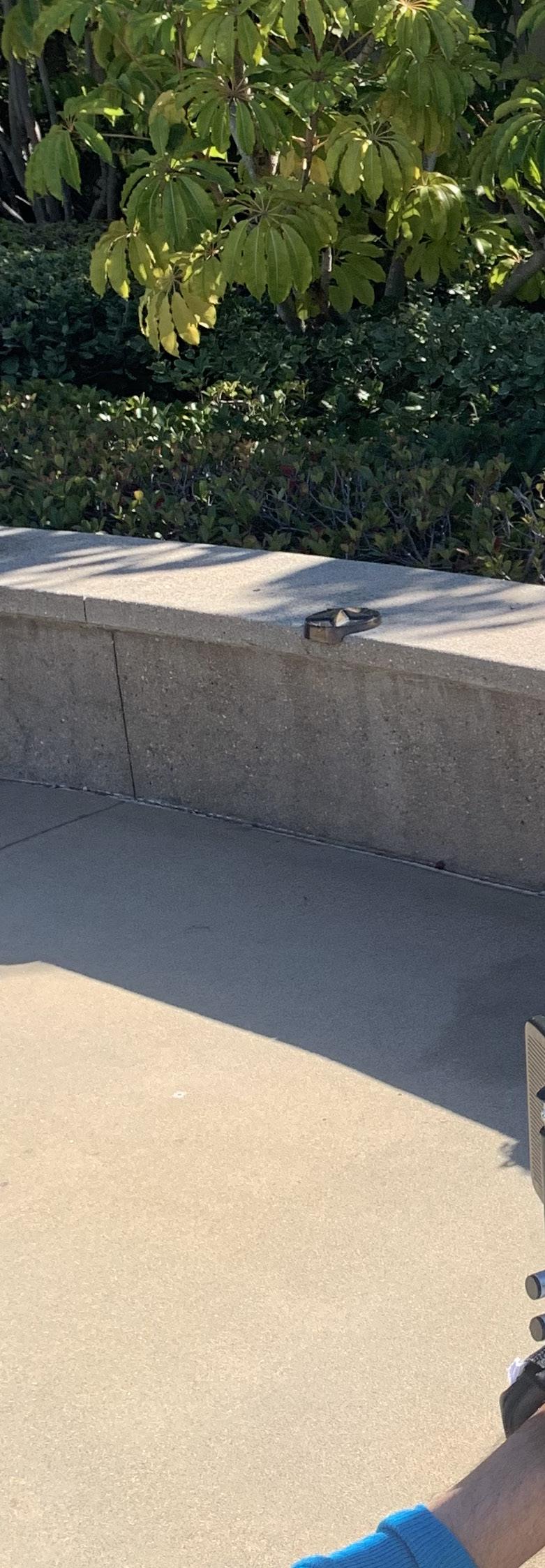
5 minute read
REAL ACCESSIBILITY ON CAMPUS
WRITTEN BY GIA KRUPENS
Picture yourself walking to class. In the morning, campus is typically cold and crowded.
Skateboards and scooters ride by, cutting you off and getting a little too close for comfort. You make your way up the ramp from lower campus to upper campus. It somehow gets steeper every morning and you’re more exhausted than you’d like to admit by the time you get to the top.
But you’re not done there. You continue your trek getting misted by the water from the fountain in front of Brotmall Hall. From behind the Go Beach sign, you squeeze yourself between the gap to save a few seconds of walking. You go up the escalator (when it’s working), grateful for the quick rest, before continuing on. You maneuver your way around upper campus- climbing the sets of stairs that liter the campus, fitting yourself through shortcuts and trudging up the hills around the quad. By the time you reach your seat in class 15 minutes later, you’re tired.
Now imagine that you can’t do half these things. You can’t walk the ramp because it’s too steep so you have to find an alternate route around it. There’s no way for you to go up the escalator or stairs by the University Student Union, so you have to wait an extra few minutes for the elevator. You have to avoid all stairs on campus, so the paths take you around the backs of buildings and through hallways you didn’t know existed. This more than doubles your time from the parking lot to class.
After an electric skateboarding accident in September 2022 this is the route that Josh Licata, a 21-year-old junior, had to take when he returned to campus.
“I am patient zero for this injury,” Licata said. “I don’t have a case to follow. If you break your arm, they’ll say you should be recovered by a date. I don’t have that.”
When Licata had his accident he shattered his entire knee joint. During his reconstructive knee surgery, he had eight screws and a plate installed in his leg. Because his surgery was so intense and his recovery was so unpredictable, he spent four months of his recovery in a wheelchair.
When he began returning to classes again, he quickly noticed how much more difficult it was to get around when he couldn’t do it on his own two feet.
“That main pathway on campus . . . it’s quite a steep incline,” Licata said, referencing the pathway in the quad outside of the science buildings. “I wasn’t able to go up it because it was just too tiresome, so I wouldn’t take the main pathway. I wouldor to certain spots on campus.
Licata mentions his friends and family as a huge help to him during his time in a wheelchair, and even now as he continues to recover by using crutches. His mom helped him get to and from school everyday and set up his wheelchair, and his friends were always there when he needed help moving around campus. He makes sure to bring up the kind treatment that he received from Long Beach State’s students around campus.
“One time in the library the elevator was full,” he said. “This one girl saw me and got out of the elevator because it was packed. She was like ‘Here, you can take my spot’ and she took the stairs.” go between the liberal arts buildings and the path in front of the bookstore.”
This instance is just one example of the kindness that Licata felt from students on campus. From doors being held and people being cautious to stay out of their way for him, Licata believes that the students have shown him lots of courtesy and compassion on campus- something that he is very grateful for.
The Long Beach State campus offers wheelchair accessible pathways, but the walkway that Licata is referring to as ‘too steep’ is one of those. In fact, as he looks at the accessibility map of Long Beach State’s campus, he points out multiple highlighted routes that he would avoid and even a few unhighlighted routes as ones he would take.
He brings up a few more examples of the challenges he faced while on campus. The wheels on his wheelchair would get stuck in the cracks between the sidewalk by the liberal arts buildings. The handicapped accessible door on the front of the Molecular & Life Sciences Center sometimes doesn’t open when the button is clicked, making it impossible for handicapped students to get into the building without help. There were times when Licata would have to phone a friend in order to get inside of a building
Still, campus is littered with paths and hallways that claim to be accessible, yet prove to be a challenge for those who need them most. Case in point, even the Bob Murphy Access Center has stairs in front of it. An “accessible campus” needs to truly be accessible to all students- which is more than just adding the ramps and paths needed for these students, but to do the work to make sure that they are consistently working and are not isolating.
Today, Licata is still in the midst of his recovery process. Though he has a long way to go, he is hopeful about life post-accident. He doesn’t plan to let his accident stop him from skateboarding again in the future.
“You either get back up or you never ride the horse again,” Licata said. “For me, I’m going to get back up.”










